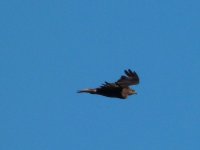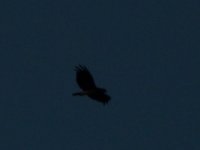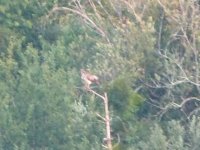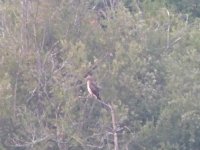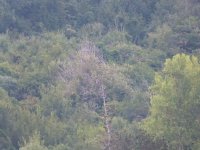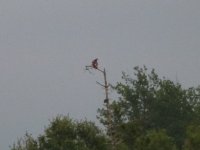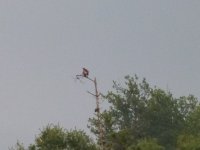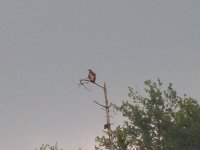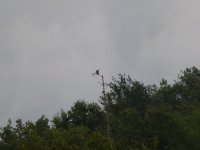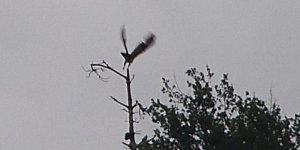I regret to say I am back to square one. Very confused so it is best to ask for help!
Three days in a row there were lots of Hooded crows gathered to the west, each time around 7pm. Yesterday I went to have a look. A large raptor came from south in the direction of the little wood by the house over which HBs have circled and called in 2014 and this year (18 and 28 July). As it approached the wood, another bird erupted from the trees there, making the first bird swerve and head west (pic 1). I followed it and never saw properly the second bird.
I was still outside an hour later. I heard slow calls (ones that sounded like the STE adult's cries to the juvenile that I've heard a few times recently, it is not the usual general calling). The caller was a large raptor flying over the house and terraces, heading south. I got one lousy dark shot (pic 2). I saw it wing across the field and land in a tree on the opposite slope (pic 3; 20.19). I expected it to fly again but it did not move, my last shot of it was at 20.45.
This morning I was down at the bottom of the terraces below the house at 0545. Still too dark to see if the bird was in the tree, but photo at first decent light 0613 shows the tree with no bird. At 0619 there suddenly was that pale-breasted large bird very erect at the top of the tree. A lot of cloud over the eastern hills, the bird was still, facing east (pics 4 & 5). At 0707 I began to fiddle with my camera, trying to get a half decent image so that I could identify the bird. At 0709 I looked up to see golden light and an empty tree.
Bird in pic 1 : the iris is brown but the face does not look CB to me. No underwing patterning nor outline of shape to help me feel sure of ID.
Bird in pic 2, 3, 4, 5 : all of the same bird. What was it?
Thank you!
Kinthissa
Three days in a row there were lots of Hooded crows gathered to the west, each time around 7pm. Yesterday I went to have a look. A large raptor came from south in the direction of the little wood by the house over which HBs have circled and called in 2014 and this year (18 and 28 July). As it approached the wood, another bird erupted from the trees there, making the first bird swerve and head west (pic 1). I followed it and never saw properly the second bird.
I was still outside an hour later. I heard slow calls (ones that sounded like the STE adult's cries to the juvenile that I've heard a few times recently, it is not the usual general calling). The caller was a large raptor flying over the house and terraces, heading south. I got one lousy dark shot (pic 2). I saw it wing across the field and land in a tree on the opposite slope (pic 3; 20.19). I expected it to fly again but it did not move, my last shot of it was at 20.45.
This morning I was down at the bottom of the terraces below the house at 0545. Still too dark to see if the bird was in the tree, but photo at first decent light 0613 shows the tree with no bird. At 0619 there suddenly was that pale-breasted large bird very erect at the top of the tree. A lot of cloud over the eastern hills, the bird was still, facing east (pics 4 & 5). At 0707 I began to fiddle with my camera, trying to get a half decent image so that I could identify the bird. At 0709 I looked up to see golden light and an empty tree.
Bird in pic 1 : the iris is brown but the face does not look CB to me. No underwing patterning nor outline of shape to help me feel sure of ID.
Bird in pic 2, 3, 4, 5 : all of the same bird. What was it?
Thank you!
Kinthissa




